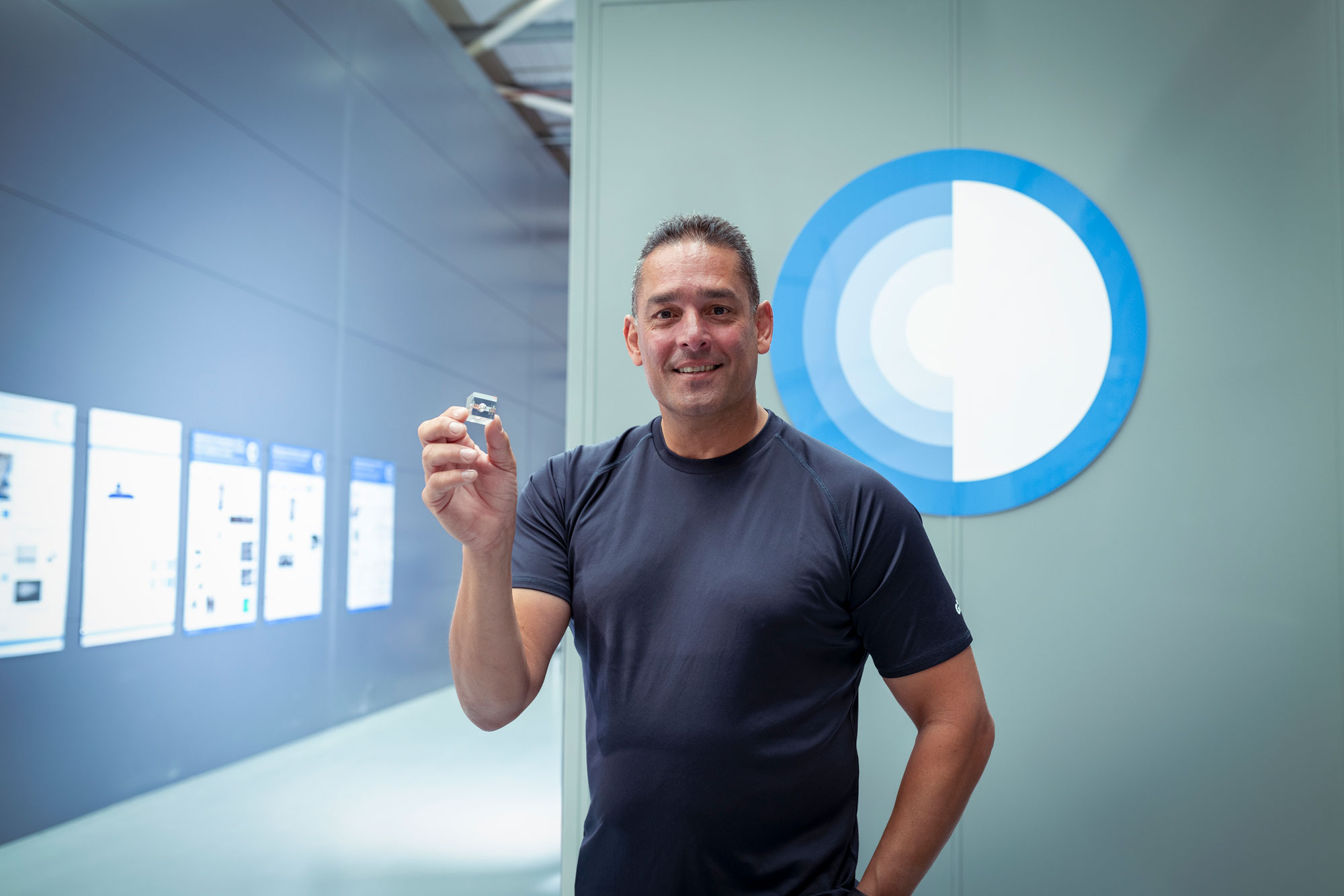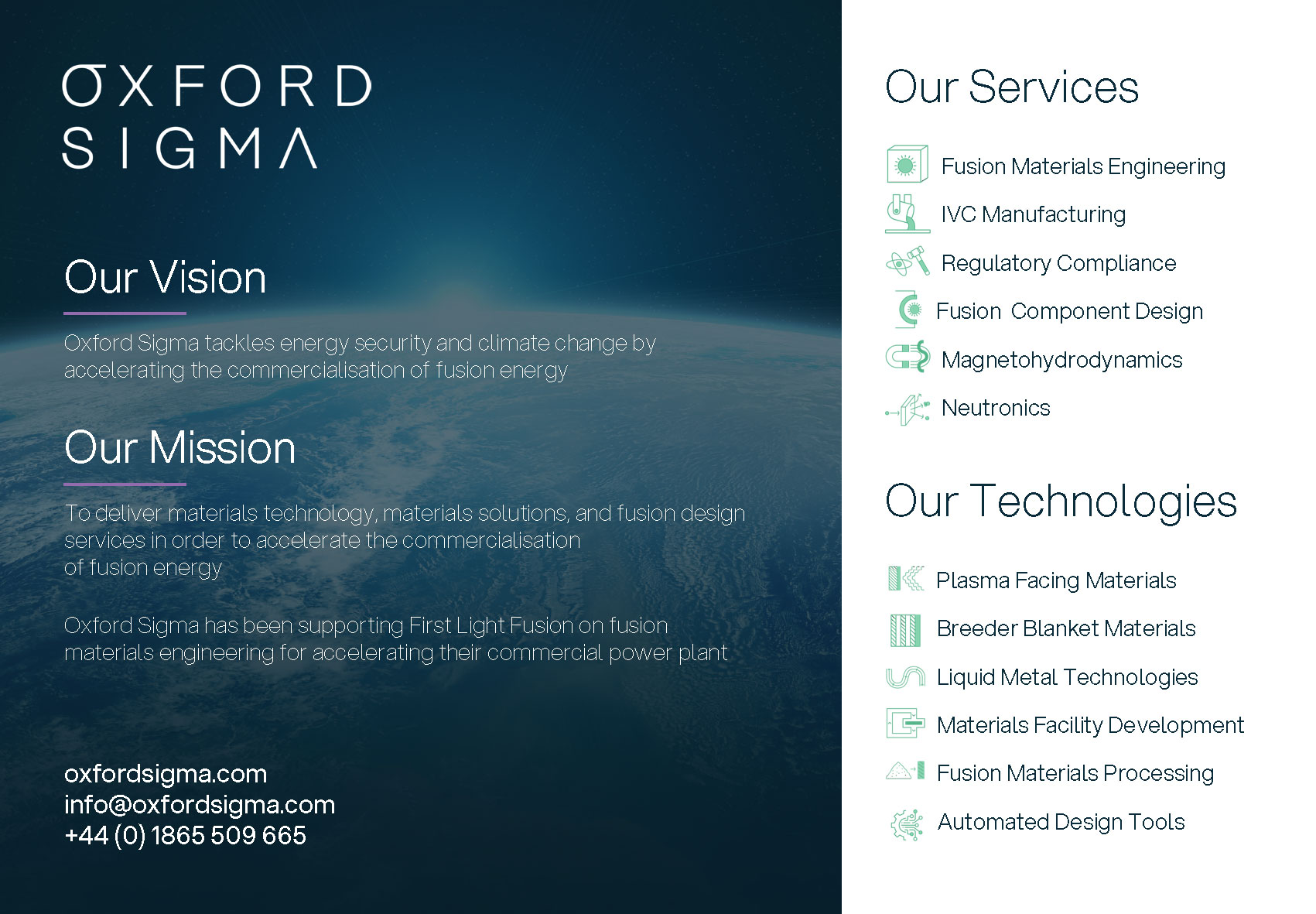First Light Fusion
The Modern, Simple Approach to Fusion
First Light Fusion is building the world’s largest pulsed power facility in preparation for construction of a power plant that will prove the ability to create clean energy through inertial confinement fusion. The goal for the business is to make it as easy and affordable as possible in a mission around simplicity. COO Ryan Ramsey talks to Energy Focus about progress on site in the UK.
“Climate change is real. Renewables need to take prominence and we are one part of the renewable solution,” says Ryan Ramsey, Chief Operations Officer at First Light Fusion (FLF).
The Oxford-based fusion business is lighting the way to a cleaner world by using science and technology to do things that have not been done before.
The company was established in 2011 following research from Oxford PhD student Dr Nick Hawker, who found an idea in nature for achieving fusion – where two or more atomic nuclei combine to form a heavier one, releasing enormous energy.
Pistol shrimps snap their claws at unbelievable speed to create an air bubble that hurtles toward prey, stunning or killing it. The bursting bubble creates a sound louder than a gun, and the process had Hawker thinking about the physics.
“The three things you need for fusion is time, density, and energy, and this satisfied all of that. Concentrating on Inertial Confinement Fusion (ICF), he developed the concept of firing a projectile at a target that has deuterium and tritium. The projectile itself doesn’t have the necessary velocity itself to create the conditions for future. You need to reach 60km/s which is very fast. Using the unique amplifier technology we have developed over the last 12 years we can speed up the projectile and fire it even faster, collapsing the deuterium and tritium to fuse together. We was achieved that for the first time in November 2021, proving our unique approach,” explains Ramsey.
What Hawker and team had found was a way to replicate the process that creates energy within the sun. Complex and often unknown, to achieve fusion in 2021 was a major milestone.
Importantly, the work done by FLF is advancing knowledge of how to create energy using fusion, affordably, and safely in a way previously thought of as impossible. In the UK, where the energy mix is still largely reliant on oil and natural gas, modern ideas are required to innovate a system that hits Net Zero by 2050.
“We are not competing with wind, solar, tidal, or fission. To sort the problem across the world, we need a combination of all of these things and we see 500MW fusion plants around the world, using our technology to achieve success,” says Ramsey.
BUILDING
Currently, the team at FLF is busy. Amongst driving an ambitious funding round and recruiting the world’s brightest talent, there is a hopeful build programme advancing at pace. The next stage is speeding up the projectile launch and then understanding the science around using the technology within a power plant setting.
“We are designing our prototype pilot plant which we expect to be operational in the 2030’s – it’s an aggressive timeline but that allows us to achieve great things. Before that, we are going to build the largest pulse power machine in the world called Machine 4. That will be on the UK Atomic Energy Authority’s campus and is very exciting,” explains Ramsey, a former Navy submarine Captain and energy industry leader.
Brought in to ensure timelines are met, Ramsey is enjoying the purpose-led nature of the business and describes each day as thrilling, with the buzz of a start-up despite medium-sized status.
“Achieving fusion is one thing, but if you only get a few neutrons then that doesn’t turn into a power plant or solve the problems of clean energy for the world. So we have to be faster, and there is no gas gun or alternate technology available able to achieve the speed,” he says.
So FLF is busy designing its own system – the world’s most powerful pulsed power facility – Machine 4. This technology accumulates large amounts of electromagnetic energy and releases it instantly, in a process similar to that used in high-powered military rail guns.
In 2018, FLF built a pulsed power machine named Machine 3, the largest of its kind in Europe. “But Machine 3 can only bring the projectile to 20km/s. The next challenge is going even faster, and that is why we need its successor, Machine 4,” says Ramsey. “It will be 72 metres in diameter, 12 metres high, and should get us to 60 km/s which would allow us to achieve ‘Gain’. That is important as it de-risks the pilot plant. We are making sure that by the time we get to the power plant, we have de-risked all of the technology so that we can achieve what is required, and the science is correct.”
This vital step in the process should be complete by the end of 2023 with detailed design scheduled for next year. Using its own AI platform, developed in house at FLF, the company has been able to run hundreds of thousands of tests to predict outcomes and test theories. “That gives us confidence,” says Ramsey. “Right now, we are on the sixth iteration of the design of the machine to refine so that it achieves what it should.”
DRIVEN BY SIMPLICITY
When the science and technology is refined, the concept of fusion is expected to provide clean energy in volumes not seen before. But doing so must be sustainable and this is why FLF concentrates on simplicity.
“Everybody is focused on the same mission, which is to solve the problem of fusion with the simplest machine possible – this is our power plant,” explains Ramsey. Machine 4, which is only the company’s Gain demonstrator, is being designed with low-cost, off the shelf components, and the power plant concept is intentionally simple.
“Solving fusion physics is not enough, the world needs a technology that can be built at scale,” he adds. “We have solutions for each of the problems you have with managing fusion. A big problem is the price – it can be very expensive – but our proposal makes it relatively cheap.”
Long-term sustainability is also about the supply chain. Theoretically, the idea where small modular reactors power a city or a small town is much more suitable for FLF. But if the company was to expand aggressively and begin international rollout of its innovation, local supply chains would need to be able to deliver.
“Building a sustainable supply chain can be a challenge and the reason is education and educating people about fusion and what it is,” admits Ramsey.
Fusion as a concept goes back a long way in history with the first real research happening in the 1920s.
“It feels very new, not dissimilar to when electric vehicles started moving on the roads,” Ramsey suggests. “People didn’t know how to operate within that, and the supply chain needed to establish itself. This is the same for Fusion. If we suddenly scale to 100 power plants, we must know there are local supply chains able to support that.”
People in those business that make up the supply chain must also have the knowledge and ambition to participate at scale, on something new and different, while adhering to the strictest international quality standards.
“Generating people with physics capability – PhDs, Masters, graduates, post-docs – takes a lot of time,” details Ramsey. “Physics should be way more attractive than it is to young people. The reason the way our world is the way it is, is because of physics. But our education system doesn’t support that – it doesn’t make physics exciting. We have a massive outreach programme underway now to reach into schools and to show learners the end point and how physics changes the world.”
He says that when people visit the site in Oxford, home to some of the brightest minds in the industry, there is a sense of excitement. It’s busy, it’s fast moving, there’s a feeling of energy in the air.
“It has that start-up mentality and there are clever people, very focussed on achieving our mission. The next time a student goes into a physics lesson, the teacher can lever in a memory of a trip to First Light Fusion and make the subject relevant,” Ramsey hopes.
FLF is also keen to progress learners through the years to ensure curiosity continues. Follow up experiences are organised to ensure bright young minds can work in the business while they learn. As they progress through years, FLF supports with degree, Masters and PhD studies, and not only provides insight to fusion, but lays down challenges.
“Everything that is done is about coming up with great ideas,” states Ramsey. “We want young people contributing here, and most of the PhDs we have in the company have come here to complete their studies and they ultimately stay with us. We challenge them with real problems that we don’t know the answers to in order to ignite creativity.”
Partnering over the long-term with industry leaders has also been essential for the development of pathway for FLF. Whether in design, engineering, theoretical knowledge, safety, or many other areas, the company must lean on external expertise as the community comes together to drive achievement.
Ramsey highlights the relationship with neighbours Oxford Sigma as a perfect example of deep partnerships that will yield results.
“Oxford Sigma has a really strong skillset in materials. We don’t have any materials people in our organisation but they are experts in that. Where we don’t have the capability, we outsource to trusted partners. Oxford Sigma worked with us previously and that was really positive. We have just partnered with them to look at lithium as part of the Fusion Industry Programme. We partnered with them because we believe they have the expertise in areas that will help us and others, and therefore they should lead there rather than us – it’s a great relationship.”
VERY INVESTIBLE
The key challenge for the business moving forward now is funding. The science is there, the desire for modern, clean energy is constant, and the investment case of FLF is powerful. The senior leadership team must go out and attract investment to ensure the build of M4 and the pilot power plant (likely to be a 60MW, capex intensive project).
“The fundraise is going well, and it comes from a variety of different sources,” says Ramsey.
“We are privately funded, and that means we are moving fast. It’s amazing what private funding does to solve this problem. If you look at government organisations that are doing similar things, we are moving so much quicker. Funding from the private sector is key.”
Importantly, the business is transitioning from research organisation and Oxford spinoff, to revenue generating business with a realistic route to market. In July 2023, the company partnered with Spanish firm IDOM UK Nuclear Services to identify potential for production of medical isotopes in the reactor. Research suggests that the temperatures in the reactor would be easily strong enough to produce radionuclides for pharmaceutical application in a market that is growing by 9% annually. Production of medical isotopes remains low in sparse around the world, but demand is high because of uses including detection and treatment of illnesses including cancer and heart disease.
“When we identified the potential not only to produce, but also harvest these much-needed medical isotopes which are having an increasing impact on the diagnosis and treatment of serious illnesses, it was incumbent on us to explore the opportunity. Importantly this can be realised with no compromise to the reactor’s ability to produce electricity; it is a purely additive opportunity,” said Nick Hawker.
“It is very promising,” adds Ramsey. “Investment is always a challenge, and particularly in the environment we are in at the moment. With the right programme and demonstrable achievements, we provide confidence to investors. The next raise will enable us to build the Machine 4. It will be the world’s largest pulsed power machine, based in the UK, and it will not only contribute to our journey, but to broader science nationally and internationally. This levers off a report from the Royal Society where many organisations have provided innovative ideas on how to use the machine more broadly.”
He adds that having an effective commercial model allows investors to see ROI. “As long as we can demonstrate progress and returns, it is very investable.”
FLF is solving the problem of fusion and the optimism and ambition within the company is one of the key catalysts.
“We fail fast, and when we fail we pivot and move in a different direction. That is how we have got to where we are,” says Ramsey. “There is a lot going on around us and we could end up comparing ourselves to others, but that is not an effective way to focus. We breed positivity and we recognise that we are going to fail. We learn lessons quickly and we use the code to change the target and move on. We are definitely moving in the right direction, but the healthy tension is that we want to move faster. This is not an experiment – this is a solution to the problem of fusion, making sure it can be turned into power plants, and ensuring our children’s children can have a world that is worth inheriting.
“When we get this right, I will be very proud to say that I had a part in it, and that fulfils my need for purpose,” he concludes.

Ryan Ramsey, COO




